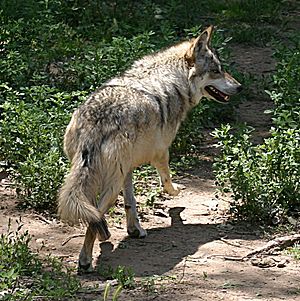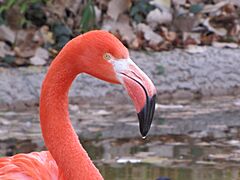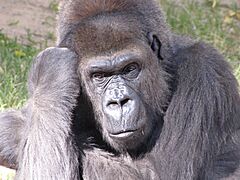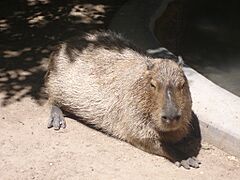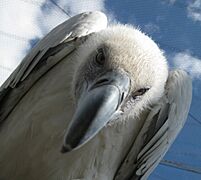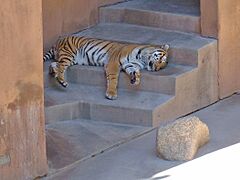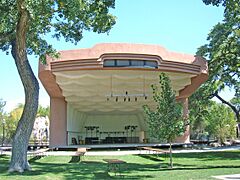ABQ BioPark Zoo facts for kids
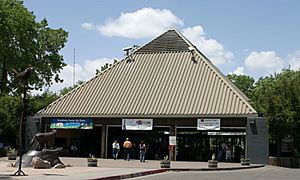
Main entrance
|
|
| Date opened | 1927 |
|---|---|
| Location | Albuquerque Biological Park, Albuquerque, New Mexico, United States |
| Land area | 64 acres (26 ha) |
| Coordinates | 35°04′39″N 106°39′46″W / 35.0776°N 106.6627°W |
| No. of species | 200+ |
| Memberships | AZA |
The ABQ BioPark Zoo is a fantastic place to visit in Albuquerque, New Mexico. It's part of the larger Albuquerque Biological Park. This zoo first opened its doors in 1927 and was known as the Rio Grande Zoo. It covers a huge area of 64-acre (26 ha)!
At the zoo, you can explore different areas like the Africa exhibit, the Australia exhibit, the "Cat Walk," and a special area for reptiles. In 2016, a fun carousel featuring endangered animals was added. You can even ride a narrow-gauge railroad that connects the zoo to other parts of the BioPark. Walking through the entire zoo is about 2.27 miles (3.65 km)!
The Albuquerque Biological Park is a proud member of the Association of Zoos and Aquariums (AZA). This means it meets high standards for animal care and conservation.
Exploring the Zoo's Amazing Exhibits
Flamingo Crossing
Right at the start of the zoo, you'll find Flamingo Crossing. This is a beautiful island surrounded by water, where the zoo's flock of Caribbean flamingos live. The island is full of green bamboo plants, making it a perfect home for these colorful birds.
Reptile House

The Reptile House got a cool makeover in 2012. Now, it's mostly home to many different kinds of reptiles. You can see lots of snakes, tortoises, and lizards here. There are also two big areas where the zoo's amazing Komodo dragons live.
Near the Reptile House, there's another building that temporarily houses a huge adult saltwater crocodile and some slender-snouted crocodiles. Outside, you'll find the Gator Swamp Exhibit. This is a large, heated outdoor pool where several adult American alligators hang out. The Reptile House was updated again in 2017 with new digital signs and interactive displays to help you learn even more!
Texas Horned Lizards and Conservation
Five Texas horned lizards, born at the zoo in August 2019, are now on display in the reptile building. The zoo has been working to breed these lizards since 2017. Texas horned lizards have disappeared from many places where they used to live. This is because their homes are being lost, people have removed the ants they eat, and invasive fire ants have taken over. So far, the zoo has successfully released about 70 young lizards into the wild in Socorro County, New Mexico. This helps bring the species back!
- Alligator snapping turtle
- American alligator
- Asian water monitor
- Black mamba
- Blue iguana
- Chinese alligator
- Forest cobra
- Gray-banded kingsnake
- Green anaconda
- Green tree python
- King cobra
- Komodo dragon
- Mangshan pit viper
- Mexican garter snake
- Ornate box turtle
- Plumed basilisk
- Quince monitor
- Saltwater crocodile
- Tentacled snake
- Texas horned lizard
- West African slender-snouted crocodile
Raptor Roost
At Raptor Roost, you'll find several large aviaries. These are big enclosures where birds can fly. Here, you can see impressive birds like Andean condors, golden eagles, great horned owls, and Steller's sea eagles.
Mexican Wolf Exhibit
This exhibit is home to the zoo's pack of Mexican wolves. These wolves are the most endangered type of wolf in the United States. In June 2020, two Mexican gray wolves named Kawi and Ryder had seven pups! This was their second litter, with five boys and two girls.
Inukshuk Bay
Inukshuk Bay is a large and exciting exhibit for the zoo's polar bears. You can watch them through special underwater windows, or walk to the top of the exhibit. From there, you can see the bears relaxing, eating, and even sliding down a waterfall!
Catwalk
The Catwalk exhibit features special areas called grottos, which are like small caves. These grottos are home to the zoo's big cats and other animals. In March 2023, two African lion siblings, Kenya and Dixie, moved to the Abilene Zoo because the Catwalk was being updated.
Amphibians: Life on a Limb
When the Reptile House was renovated in 2012, the zoo also opened "Amphibians: Life on a Limb." This new area replaced the old Gator Swamp, which used to house young alligators. This building is now home to many different kinds of frogs and other amphibians. The zoo also has the only group of locust coquis living in a zoo anywhere in the world. These tiny frogs from Puerto Rico are critically endangered, meaning they are at a very high risk of disappearing forever.
Asia Exhibit
The Asia exhibit was originally designed for the zoo's Asian elephant herd, which includes two males and four females. It had several elephant yards and two barns. In 2023, this area was made even bigger! New flexible exhibits were added for the zoo's orangutans, siamangs, tigers, and snow leopards.
Australia/Koala Creek
In September 2018, the zoo began big plans to expand its Australia area. The old seal pool was closed and is being used for this new expansion. New animals joining this area include dingos, little penguins, wallabies, and koalas returning to the zoo! The zoo will also have updated homes for most of its current Australian animals, and it will be a new home for the zoo's saltwater crocodile.
Africa Exhibit
The Africa exhibit covers six acres of land. It has 17 different exhibits and is home to 23 different kinds of mammals and birds from Africa.
- African wild dog
- Black-and-white ruffed lemur
- Cape vulture
- Capybara
- Chimpanzee
- Common warthog
- Hartmann's mountain zebra
- Hippopotamus
- Klipspringer
- Lappet-faced vulture
- Marabou stork
- Reticulated giraffe
- Saddle-billed stork
- Southeast African cheetah
- Southern white rhinoceros
- Spotted hyena
- Wattled crane
Ape Walk
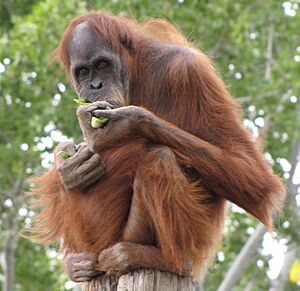
This special trail is where the zoo's apes live. You can see animals like siamangs and western lowland gorillas here.
Birds of the Americas
This aviary mixes five different bird species from North and South America. You can spot burrowing owls, Gambel's quails, greater roadrunners, hyacinth macaws, and sun conures all living together.
Penguin Chill
In July 2019, the highly anticipated Penguin Chill exhibit opened! This amazing, multi-million dollar exhibit was paid for by a city tax bond. It features gentoo penguins, macaroni penguins, and king penguins. It's the first exhibit of its kind in the Southwest United States!
The building is 14,550 sq ft (1,352 m2) and includes a huge main tank that holds 75,589 US gal (286,140 L; 62,941 imp gal) of water. You can view the penguins from above ground or through underwater windows. There's also a large, interactive learning area and an outdoor deck overlooking the zoo's main park. The outdoor deck even has restrooms and a snack bar.
The exhibit starts with a themed viewing deck that gives visitors a wide view of the penguins. The main pool is deep, ranging from 5 to 12 feet (1.5 to 3.7 m), giving the penguins lots of space to swim and play. You can even watch special public feedings with the zookeepers! There's a cool glass floor area where you can see penguins swimming right beneath your feet as you walk through the exhibit. The exhibit uses natural day/night and seasonal lighting cycles to help the penguins feel at home and encourage them to breed. The zoo hoped for baby penguins, and in 2020, two macaroni penguin eggs were found, but sadly, they were not fertile.
Birds of the Islands
Opened in 2020, the Birds of the Islands exhibit is located where the old parrot habitat used to be. This exhibit is part of the zoo's Americas Trail. Next to the bird aviaries, there's also an exhibit for giant Aldabra giant tortoises.
Gallery
-
A thoughtful Gorilla
See also
 In Spanish: Zoológico de Río Grande para niños
In Spanish: Zoológico de Río Grande para niños


